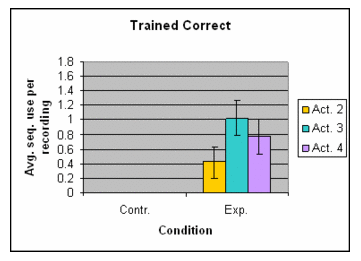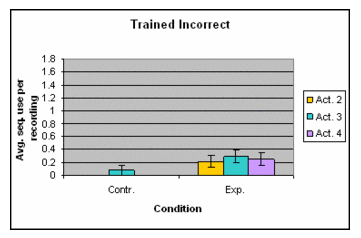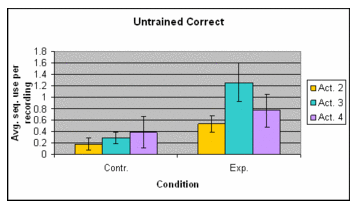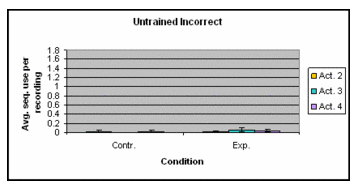Fluency Summer Intern Project 2008
Contents
[hide]Abstract
The following reports the findings from the summer intern project of Megan Ross (Northwestern University) in June and July 2008. It concerns an analysis of the data gathered in Spring 2008 for Study 2 of the project Fostering fluency in second language learning (De Jong, Halderman, and Perfetti).
Data was analyzed of 30 students of English as a second language, who had received a 50-minute training on formulaic sequences, followed by three sessions of the 4/3/2 procedure, which is designed to promote fluency.
Results showed that students who were trained to use formulaic sequences used more of them in subsequent speeches -- both trained and untrained sequences. However, the formal accuracy of trained formulaic sequence was lower than that of untrained sequences. This indicates that the students may not have stored the trained formulaic sequences as chunks, and that they were more aware of the function of formulaic sequences to signal the structure of a speech.
Background and significance
Formulaic sequences are prefabricated structures of a language which are relatively fixed that help people speak with fluency (Nattinger & DeCarrico, 1992). Speakers use formulaic sequences for several reasons. First of all, they allow for more efficient retrieval of other information (chunking). In addition, both the speaker and listener are able to focus on the “bigger picture” of the conversation, rather than on individual words. Finally, in L2 acquisition, using formulaic sequences helps the student sound more fluent, and provides the student with more time to think about what else they want to say (resource allocation).
Nattinger & DeCarrico distinguish between four types of formulaic sequences (or lexical phrases):
| Grammatical level | Canonical/Non-canonical | Variable/Fixed | Continuous/Dis-continuous | |
|---|---|---|---|---|
| Polywords
(e.g., For the most part...) |
word level | both | fixed | continuous |
| Institutionalized expressions
(e.g. Have a nice day) |
sentence level | canonical | fixed | continuous |
| Phrasal constraints
(e.g., A [long time] ago…) |
word level | both | somewhat variable | mostly continuous |
| Sentence builders
(e.g., Not only X, but Y) |
sentence level | canonical | highly variable | often discontinuous |
Research questions
Two competing theories about the acquisition and use of formulaic sequences were considered. Two theories of how formulaic sequences are learned (correctly and incorrectly):
- Language is proceduralized and automatized in grammatically correct chunks. If the structure of the sequence is incorrect, then the formulaic sequence has not been proceduralized (Towell et al, 1996).
- Language is learned holistically for L1, but (older) L2 learners process formulaic sequences at the word level. Consequently, incorrect formulaic sequence use is a result of constructing the sequence from parsed speech (Wray, 2002).
In this study, we investigated whether ESL Students who are trained to use formulaic sequences will use them more often and with greater accuracy, as compared to ESL students who do not receive the training.
Method
The participants in this study were 30 ESL students enrolled in the English Language Institute of the University of Pittsburgh, at levels 3 and 4 (low and high intermediate). At the beginning of the semester 17 students received a 50-minute pretraining in which they learned the form and use of 10 formulaic sequences through listening, fill-in-the-blank exercises, and partner-work (Formulaic Sequences condition). The other 13 students did not receive this training (No Formulaic Sequences condition).
In the weeks following this training, during the first half of the Spring 2007 semester, the students performed the 4/3/2 procedure (see Fostering fluency in second language learning) three times. They also performed three Recorded Speaking Activities at the beginning, middle, and end of the semester, which served as pretest, posttest and delayed posttest.
Independent variables
- a. Pretraining vs. no pretraining of formulaic sequences
- In the Formulaic Sequences condition, students receive a short training of a number of formulaic sequences before they start the fluency training (4/3/2 task). In the No Formulaic Sequences condition, students do not receive this pretraining, and only do the 4/3/2 task.
- b. Low intermediate vs. high intermediate proficiency level
- Low intermediate students are enrolled in ELI Speaking courses at level 3, high intermediate at level 4.
Dependent variables
- Temporal measures of fluency:
- Articulation rate: number of syllables per second
- Pauses:
- mean length of fluent runs between pauses
- mean length of pauses
- phonation/time ratio
- Formulaic sequences:
- number of correct and incorrect formulaic sequences repeated from training (trained sequences)
- number of other correct and incorrect formulaic sequences (untrained sequences)
- Near transfer, immediate and delayed, normal post-test: After completing the last training session, students performed a similar task (spontaneous speech about a given topic), to test whether any gains in fluency during the training task were maintained in a new instance of the same task. This test was given one week and four weeks after the last training session, each time with a different topic. These recordings were made as part of the Recorded Speaking Activities (RSAs) from the project "The self-correction of speech errors (McCormick, O’Neill & Siskin)".
Hypotheses
- Students who were trained to use formulaic sequences will use more formulaic sequences in subsequent speeches than students who did not receive this training.
- Students who use formulaic sequences will speak with higher fluency (higher phonation/time ratio and longer mean length of fluent run) than students who do not.
Findings
General Linear Model analyses revealed the following significant effects.
Trained correct
- Group: F(1, 28) = 11.87, MSE = 1.02, p<.05
- Activity: F(2, 56) = 2.74, MSE = .23, p=.07
- Group*Activity: F(2, 16) = 3.61, MSE = .41, p<.05
Trained incorrect
- Group: F(1, 28) = 9.16, MSE = .13, p<.05
Untrained correct
- Group: F(1, 28) = 4.96, MSE = 1.44, p<.05
Untrained incorrect
- Group: F(1, 28) = .71, MSE = .02, p<.05
In summary:
- Students in the trained condition used more formulaic sequences than students who were untrained.
- Students in the trained condition attempted more sequences (incorrect use) than students who were not trained.
- Untrained sequences were not taught in the training, but when students used the untrained sequences, they were very accurate.
- Activity 3 may have yielded higher sequence use than Activities 2 and 4 because of the topic.
- Overall, there was significantly more correct use in both the trained and untrained conditions.
- Data from the Recorded Speaking Activities showed no trends connecting formulaic sequence use to measures of fluency.
- Other observations
- Arabic speakers rarely (if ever) used any formulaic sequences.
- Korean and East Asian speakers used more untrained sequences than trained sequences, in both conditions.
Explanation
Because formulaic sequences are not taught extensively in the regular ELI classes, the sequences can be assumed to have been mostly unfamiliar to the students in the No Formulaic Sequences condition. Most students who received the pretraining attempted to use at least some of the sequences in some of their speeches. However, students seemed to have difficulty remembering the exact form of the sequences, resulting in ungrammatical phrases like It seems me that and To give you example. This indicates that the students had not stored the sequences as chunks, but rather re-generated them every time, using their current interlanguage grammar. This supports Wray’s claim that adult L2 learners process formulaic sequences at the word level.
If the sequences indeed were re-generated instead of retrieved as chunks, this explains why no beneficial effect on fluency measures was found: cognitive headroom was not created, and instead may have decreased as students were struggling to remember the correct form of the sequences.
It was found that the students who had received the pretraining used more untrained sequences as well. It appears that the training made these students more aware of the functions of the sequences, such as exemplifying (To give an example, ...) and clarifying (What I'm trying to say is that ...). Instead of using the ‘difficult’ newly learned sequences, students resorted to better-known, shorter sequences, such as For example ... and In my opinion ...
Increased use of formulaic sequences in Activity 3 as compared to Activities 2 and 4 may be related to differences in attention allocation. In Activity 2 (the first 4/3/2 session after the training), students were still somewhat unfamiliar with the 4/3/2 procedure and paid little attention to using the sequences. In Activity 3, students knew what was expected and had more cognitive resources available to focus on using the sequences. In Activity 4, roughly 2.5 weeks after the pretraining, memory of the sequences may have faded, and students’ attention may have been directed elsewhere, e.g., to preparing for the upcoming Recorded Speaking Activity (which is graded on accuracy, among others).
Further information
The data preparation and analysis of this part of the project has been performed by Megan Ross from Northwestern University (summer intern in June-July 2008), Dr. Laura Halderman from the University of Pittsburgh, and Dr. Nel de Jong from Queens College of CUNY.
The results of this project will be presented at the conference of the American Association of Applied Linguistics (AAAL) in Denver, CO (March, 2009).



